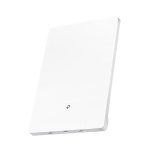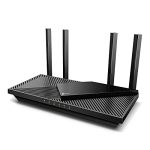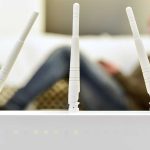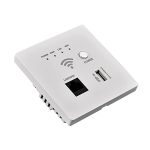To boost your WiFi signal through walls, consider repositioning your router to a more central, open spot, upgrading to a higher-gain antenna, or using a WiFi extender or mesh system. These simple steps can dramatically improve coverage without needing expensive equipment.
A strong WiFi signal through walls can feel like a magic trick, but with a few practical tweaks, you can significantly enhance your connection. Moving your router away from thick walls and metal objects helps reduce interference, while updating your hardware or adding extenders can bridge the gap behind barriers. Think of your walls as obstacles, and with some strategic adjustments, you can create a clearer path for your internet signal, ensuring smoother streaming, gaming, and browsing throughout your home or office. Whether you’re dealing with a weak signal in one room or multiple barriers, these effective tips will help you enjoy faster, more reliable WiFi everywhere.
How to Improve WiFi Router Signal Through Walls
Understanding WiFi Signal and How Walls Affect It
WiFi signals are radio waves that travel through the air to connect devices to the internet. When these signals encounter walls, floors, or furniture, they can weaken or get blocked entirely. Different materials, such as brick, concrete, or metal, impact WiFi signals differently, with some materials causing more interference than others. Knowing how walls affect WiFi helps us find the best ways to improve signal quality.
Factors That Impact WiFi Signal Strength Through Walls
Several factors influence how well your WiFi signal passes through walls:
- Material type: Thick concrete or metal walls cause more signal loss than drywall or wood.
- Wall thickness: Thicker walls weaken signals more than thinner ones.
- Distance from router: The farther devices are from your router, the weaker the signal gets.
- Interference: Other devices like microwave ovens or cordless phones can disrupt WiFi signals.
- Router frequency band: 2.4 GHz signals travel farther through walls than 5 GHz signals but are slower.
Understanding these factors helps plan the best strategies to boost WiFi signals through walls.
Choosing the Right WiFi Router for Better Signal Penetration
Selecting a suitable router is crucial for effective WiFi coverage through walls. Here are tips to choose the best device:
- Opt for a dual-band router: It offers both 2.4 GHz and 5 GHz bands, providing flexibility.
- Look for routers with high gain antennas: These antennas can transmit signals over longer distances.
- Consider mesh WiFi systems: Multiple devices work together to extend coverage seamlessly.
- Check for beamforming technology: It directs signals toward connected devices, improving strength.
Upgrading to a more powerful router or mesh system can make a significant difference in passing signals through walls.
Optimal Placement of Your WiFi Router
The position of your router plays a critical role in signal strength. Keep these tips in mind:
Center Your Router
Placing the router in the center of your home ensures even coverage and reduces dead zones.
Elevate Your Router
Position the router on a high shelf or wall mount to avoid obstacles and improve signal spread.
Keep Away from Interference Sources
Avoid placing the router near metal objects, microwaves, or cordless phones, which can interfere with signals.
Avoid Obstructions
Position the router away from thick walls or large furniture that can block signals, especially those made of dense materials.
Enhancing WiFi Signal Through Walls with External Antennas
Many routers come with external antennas that can be adjusted to improve signal direction. Here’s how to make the most of them:
- Adjust the antenna angle: Point antennas vertically or at specific angles to target certain areas.
- Use high-gain antennas: Replacing standard antennas with high-gain versions can extend signal reach.
- Orient antennas strategically: Position antennas to send signals toward spaces behind walls or into hard-to-reach areas.
Proper antenna adjustment can significantly improve WiFi penetration through obstacles.
Implementing WiFi Range Extenders and Repeaters
Range extenders and repeaters can amplify your WiFi signal to reach behind walls. Consider these options:
- WiFi range extenders: Devices placed midway between your router and dead zones repeat the signal, expanding coverage.
- Mesh WiFi systems: Multiple units work together to create a unified network across your home.
- Powerline adapters with WiFi: These use electrical wiring to carry network signals, effectively bypassing walls.
Proper placement of these devices ensures optimal signal boost behind obstacles.
Using WiFi Signal Boosters and Amplifiers
Wireless boosters amplify existing signals to overcome wall-induced attenuation. Here’s what you need to know:
- Passive boosters: These are signal amplifiers that don’t require power but are less common.
- Active amplifiers: Powered units that strengthen WiFi signals before broadcasting again.
- Placement: Position these devices in areas where the signal is weak but within range of your main router.
Choosing the right booster depends on your specific coverage needs and wall types.
Upgrading to a Mesh WiFi System
A mesh system involves multiple nodes that work together to provide seamless coverage. These systems are perfect for homes with many walls:
- Extended coverage: Mesh nodes distribute WiFi evenly, overcoming obstacles effectively.
- Easy setup: Most systems come with user-friendly apps for quick installation.
- Flexible placement: Mesh nodes can be placed in different rooms to optimize coverage.
Investing in a mesh system can eliminate dead zones created by walls and improve overall signal quality.
Optimizing WiFi Settings for Better Wall Penetration
Adjusting your router’s settings can also improve signal performance:
Switch to 2.4 GHz Band
The 2.4 GHz band travels farther through walls but offers slower speeds. Use it for devices behind thick walls.
Change WiFi Channels
Interference from nearby networks can affect your signal. Switching channels reduces congestion.
Update Router Firmware
Manufacturers often release firmware updates that improve performance and stability.
Limit Connected Devices
Too many devices can slow down your network; disconnect unused devices to improve performance.
Reducing Interference and Improving Signal Quality
Minimizing interference sources helps your WiFi signal penetrate walls more effectively:
- Place the router away from electronic devices: Keep it clear of microwaves, speakers, and Bluetooth devices.
- Use wired connections when possible: Ethernet cables provide a stable internet connection behind walls.
- Switch to less crowded WiFi channels: Scan for the least congested channels in your area.
Regularly checking for interference and adjusting settings can keep your WiFi strong behind obstacles.
Additional Tips for Better WiFi Performance Through Walls
Here are some extra tips:
- Use a WiFi analyzer app: These help identify weak spots and optimal router placement.
- Secure your network: Prevent unauthorized access that can slow down your WiFi.
- Regularly restart your router: Restarting can improve performance and fix minor glitches.
Implementing these habits can help maintain a strong WiFi signal throughout your home.
By understanding how walls impact your WiFi signals and employing effective strategies such as proper router placement, choosing the right hardware, and optimizing settings, you can significantly improve WiFi performance behind walls. Regular adjustments and upgrading your equipment ensure that your internet remains fast and reliable in every corner of your home.
How to Fix and Upgrade a Weak WiFi Signal | Ask This Old House
Frequently Asked Questions
What are effective ways to reduce interference between walls and Wi-Fi signals?
To minimize interference, position your router away from large metal objects, appliances, and thick walls that can block signals. Use 2.4 GHz and 5 GHz bands strategically, as 2.4 GHz penetrates walls better, but 5 GHz offers faster speeds over shorter distances. Keep your router elevated and ensure it’s not enclosed in cabinets or near electronic devices that can cause signal disruptions.
How can adjusting the placement of the router improve its signal through walls?
Placing your router in a central, open location prevents signal obstruction by walls and furniture. Elevate the device on a shelf or mount it higher on a wall. Avoid placing it behind large objects or inside cabinets. This positioning allows the wireless signal to spread more evenly and penetrate walls more effectively.
What hardware upgrades can enhance Wi-Fi signals traveling through walls?
Upgrading to a high-gain antenna increases the strength and coverage of your Wi-Fi signal. Installing a mesh Wi-Fi system can provide multiple access points, ensuring better coverage across walls and rooms. Additionally, using Wi-Fi range extenders or powerline adapters helps bring the signal closer to areas with thick walls or weak coverage zones.
Are there specific Wi-Fi channels or settings that improve signal penetration through walls?
Switching to less congested Wi-Fi channels reduces interference and improves signal quality. Use network analysis tools to identify the best channel with minimal overlap. Adjusting the router’s transmission power settings can also help focus the signal in desired directions, enhancing penetration through barriers without causing unnecessary interference.
How can minimizing physical obstructions impact Wi-Fi signal strength through walls?
Removing or reducing physical obstructions like furniture, appliances, and decorative items near your router can significantly improve signal flow. Ensuring a clear line of sight between your router and connected devices minimizes signal attenuation caused by dense materials, leading to a more consistent and stronger connection through walls.
Final Thoughts
Pour améliorer le signal de votre routeur Wi-Fi à travers les murs, commencez par placer le routeur dans un endroit central. Évitez de le mettre dans des coins ou derrière des meubles épais. Utilisez des répéteurs ou des amplificateurs pour renforcer la portée.
Ajustez la position des antennes pour une meilleure diffusion du signal. Mettez à jour le firmware du routeur pour bénéficier des dernières améliorations.
En résumé, comment améliorer wifi router signal through walls ? En optimisant la placement, en utilisant des accessoires adaptés et en maintenant le firmware à jour, vous pouvez considérablement renforcer la force du signal.




